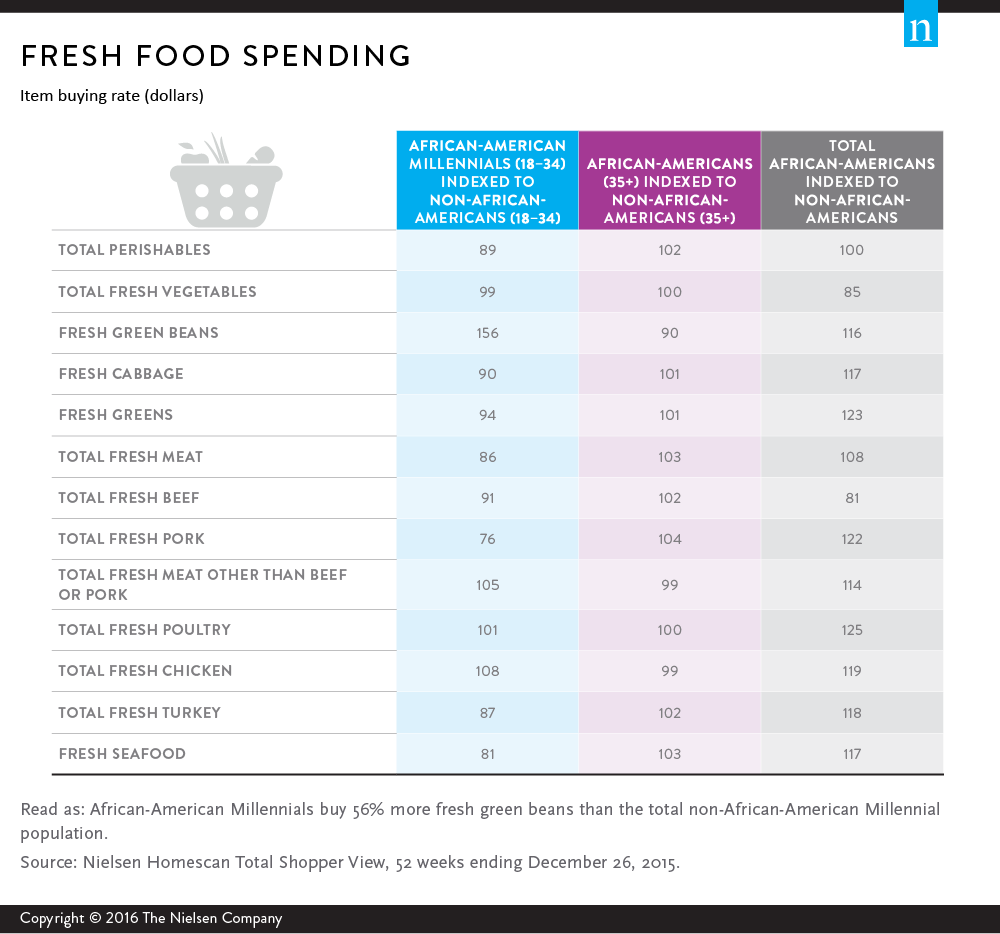Jedzenie jest jednym z najważniejszych łączników kulturowych dla afroamerykańskich kupujących w każdym wieku. Zbliżające się święta to najwspanialszy czas w roku, zwłaszcza dla sklepów spożywczych i detalicznych, które chcą przyciągnąć tych doświadczonych kupujących.
Jak wyszczególniono w raporcie Nielsena Young, Connected and Black, tradycje kulturowe związane z jedzeniem są przekazywane z pokolenia na pokolenie w społeczności Afroamerykanów. Przepisy mogą się różnić, ale istnieją podstawowe zszywki, które nadal znajdują odzwierciedlenie w nawykach zakupowych Afroamerykanów. Na przykład afroamerykańscy klienci kupują świeże mięso, takie jak wieprzowina, kurczak i indyk, oraz warzywa, takie jak świeża zielenina i kapusta, częściej niż klienci spoza Afroamerykanów. Czarnoskórzy milenialsi mają podobne produkty w swoich koszykach, ale ich zamiłowanie do świeżej fasolki szparagowej i świeżego kurczaka wyróżnia się na tle ich nieafroamerykańskich odpowiedników.

Ponadto, afroamerykańscy milenialsi i starsze czarnoskóre pokolenia kupują więcej produktów do gotowania "od podstaw" niż nie-Afroamerykanie. Do popularnych produktów należą: tłuszcz i olej; przyprawy, przyprawy i ekstrakty; cukier i substytuty cukru; syropy i melasa; mieszanki do pieczenia i nieprzygotowane mrożone mięso oraz suszone warzywa i ziarna. Wszystkie te produkty są najczęściej spotykane w posiłkach przygotowywanych na świąteczne stoły w afroamerykańskich gospodarstwach domowych. W tym sezonie sklepy spożywcze i detaliczne powinny rozważyć strategie, które łączą tradycje z doświadczeniami zakupowymi w sklepie, takie jak oferowanie na żywo demonstracji przygotowanych posiłków i wzajemne promowanie składników gotowych do spożycia w całym sklepie.
GOTOWANIE OD PODSTAW JEST CENIONE, ALE SZYBKOŚĆ I WYDAJNOŚĆ SĄ KLUCZOWE
Jeśli chodzi o gotowanie i spożywanie posiłków, afroamerykańscy milenialsi i starsze czarnoskóre pokolenia mają bardzo podobne odczucia - i to nie tylko w czasie świąt. Prawie trzy czwarte obu grup wiekowych twierdzi, że w danym tygodniu często gotuje posiłki. Obie grupy wiekowe również planują swoje obiady z wyprzedzeniem i lubią gotować ze świeżych składników.
Kiedy Afroamerykanie nie gotują świątecznych lub specjalnych posiłków, ich codzienny styl życia wpływa na ich nawyki kulinarne. Zapracowani Afroamerykanie są w ciągłym ruchu i potrzebują wygodnych rozwiązań w zakresie posiłków. Ponad połowa afroamerykańskich millenialsów zgadza się, że mrożone obiady są wygodną alternatywą dla szybkich posiłków. A jeśli weźmiemy pod uwagę, że 58% afroamerykańskich milenialsów twierdzi, że często je posiłki w biegu, nie jest zaskoczeniem, że 92% z nich twierdzi, że odwiedziło restaurację szybkiej obsługi w ciągu ostatnich 30 dni - wskaźnik ten odzwierciedla nie-afroamerykańskich milenialsów (91%). Ta potrzeba szybkości i wygody wyjaśnia, dlaczego Afroamerykanie kupują nieprzygotowane mrożone mięso, owoce morza i warzywa częściej niż nie-Afroamerykanie. Połączenie zapotrzebowania Afroamerykanów na świeżą żywność i potrzeby szybkości daje markom i sklepom spożywczym szansę na innowacje i rozwój nowych produktów w obszarze wygodnego zdrowego odżywiania.

KANAŁY ZAKUPOWE O WYSOKIEJ CZĘSTOTLIWOŚCI
Jeśli chodzi o częstotliwość korzystania z kanałów zakupowych, afroamerykańscy milenialsi i starsze pokolenia mają różne preferencje. Czarnoskórzy milenialsi wydają o 14% więcej na zakupy niż starsze czarnoskóre pokolenia, podczas gdy starsi czarnoskórzy konsumenci robią więcej wycieczek, robiąc zakupy o 23% częściej niż ich młodsi koledzy.
Wygoda i cena często dominują w decyzjach zakupowych Afroamerykanów, ale czarnoskórzy milenialsi robią zakupy w drogeriach i sklepach dolarowych częściej niż cała populacja USA. Afroamerykanie często odwiedzają sklepy ogólnospożywcze, stacje benzynowe i serwisowe oraz sklepy dolarowe. Należy pamiętać, że nie zawsze chodzi tu o preferencje, ponieważ w wielu afroamerykańskich dzielnicach są to najbliższe, a czasem jedyne dostępne sklepy. I częściowo dlatego półki w tych wygodnych sklepach często przypominają alejki w tradycyjnych sklepach spożywczych i innych sklepach detalicznych.

OBFITE OKAZJE - PODEJŚCIE WIELOPLATFORMOWE
Każdy uwielbia dobre okazje, a Afroamerykanie nie są wyjątkiem. Dlatego też, jeśli chodzi o dotarcie do afroamerykańskich konsumentów, ważne jest podejście wieloplatformowe. Afroamerykanie w każdym wieku zgadzają się, że reklama medialna wykorzystująca wiele źródeł dostarcza im znaczących lub przydatnych informacji. Jednak nawet przy podejściu wieloplatformowym, reklama w telewizji jest nadal najpopularniejszym źródłem informacji o okazjach wśród afroamerykańskich milenialsów i starszych czarnoskórych pokoleń. Większy odsetek starszych czarnoskórych konsumentów twierdzi, że reklamy w mediach drukowanych, takich jak czasopisma i gazety, są przydatnymi źródłami informacji o wyprzedażach, podczas gdy reklamy w telefonach komórkowych, radiu i Internecie wyróżniają się wśród afroamerykańskich milenialsów.

Cena jest ważnym czynnikiem przy podejmowaniu decyzji zakupowych przez Afroamerykanów. Pięćdziesiąt trzy procent Afroamerykanów twierdzi, że chętnie zmieni markę produktu, aby skorzystać z kuponu, a 62% twierdzi, że kupi produkty marki sklepowej lub marki własnej zamiast zwykłych produktów markowych, jeśli są one na wyprzedaży. Siedemdziesiąt procent respondentów zgadza się, że produkty generyczne lub marki sklepowe są tak samo skuteczne jak produkty markowe, co stanowi zmianę w stosunku do poprzednich badań Nielsena dotyczących Afroamerykanów i ich lojalności wobec marki. Marki powinny wziąć pod uwagę tę nową rzeczywistość, w której afroamerykańscy kupujący równoważą zarówno lojalność, jak i cenę w swoich rozważaniach zakupowych.
Cena, choć ważna, nie jest jedynym czynnikiem branym pod uwagę przez afroamerykańskich kupujących podczas dokonywania zakupów. Zarówno afroamerykańscy milenialsi, jak i starsze pokolenia czarnoskórych zgadzają się w większym stopniu niż ich odpowiednicy w całej populacji, że wiele innych czynników jest równie ważnych w ich kryteriach podejmowania decyzji zakupowych, takich jak rekomendacje celebrytów, najnowsze trendy, wpływ przyjaciół i rodziny oraz wizerunek marki. Czarnoskórzy milenialsi mogą być również silnymi zwolennikami marki i influencerami, ponieważ 45% z nich zgadza się, że lubi dzielić się swoimi opiniami na temat produktów i usług, publikując recenzje i oceny online - wskaźnik ten jest o 24% wyższy niż w przypadku ogółu milenialsów w USA.
Aby uzyskać dodatkowe informacje, pobierz raport Nielsena Young, Connected and Black.


